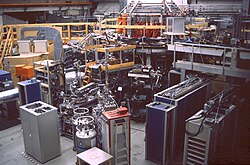


Wendelstein 7-AS in Garching. The stellarator - at the rear right - is almost covered by diagnostic and heating components.
| |
| Device type | Stellarator |
|---|---|
| Location | Garching, Germany |
| Affiliation | Max Planck Institute for Plasma Physics |
| Technical specifications | |
| Major radius | 2 m (6 ft 7 in) |
| Minor radius | 0.13–0.18 m (5.1 in – 7.1 in) |
| Plasma volume | approx. 1 m3 |
| Magnetic field | up to 2.6 T (26,000 G) |
| Heating power | 5.3 MW |
| Discharge duration | up to 2 s |
| History | |
| Year(s) of operation | 1988–2002 |
| Succeeded by | Wendelstein 7-X |
Wendelstein 7-AS (abbreviated W7-AS, for "Advanced Stellarator") was an experimental stellarator which was in operation from 1988 to 2002 by the Max Planck Institute for Plasma Physics (IPP) in Garching.[1][2] It was the first of a new class of advanced stellarators with modular coils, designed with the goal of developing a nuclear fusion reactor to generate electricity.
The experiment was succeeded by Wendelstein 7-X, which began construction in Greifswald in 2002, was completed in 2014 and started operation in December 2015. The goal of its successor is to investigate the suitability of components designed for a future fusion reactor.[3]


Wendelstein 7-AS was a stellarator, a device which generates the magnetic fields necessary for the confinement of a hot hydrogen plasma via current-carrying coils outside the plasma. They are potential candidates for fusion reactors designed for continuous operation as the current exclusively flows on the outside of the machine, in contrast to the tokamak which generates the confining magnetic fields from the current that flows within the plasma itself.
Wendelstein 7-AS was the first in a series of IPP stellarator experiments[4] with a modular coil system that creates the twisted magnetic fields necessary to confine the plasma. It was designed to give the magnetic fields more degrees of freedom that allowed it shaped closer to the optimal theoretical configuration.[5] Due to limited computing power and the need to quickly test the validity of the concept on the stellarator, only a partial optimization of the magnetic fields were carried out at Wendelstein 7-AS.[verification needed] It was only on the successor device Wendelstein 7-X that a full optimization of the code used to generate the fields were carried out.[6][7]
| Property | Value |
|---|---|
| Major radius | 2 m |
| Minor radius | 0.13 to 0.18 m |
| Magnetic field | up to 2.6 Tesla (≈ 500,000 times Earth's magnetic field in Europe) |
| Number of toroidal coils | 45 modular, non-flat coils + 10 flat additional coils |
| Plasma duration | up to 2 seconds |
| Plasma heating | 5.3 megawatts (2.6 MW microwaves + 2.8 MW neutral particle injection) |
| Plasma volume | ≈ 1 cubic meter |
| Amount of plasma | <1 milligram |
| Electron temperature | up to 78 million K = 6.8 keV |
| Ion temperature (hydrogen) | up to 20 million K = 1.7 keV (slightly more than the temperature in the center of the Sun) |

The following experimental results confirmed the predictions of a partially optimized Wendelstein 7-AS and led to the development and construction of the Wendelstein 7-X:[8]
{{cite journal}}: CS1 maint: numeric names: authors list (link)
|
Fusion power, processes and devices
| |||||||||||||||||||||||||||||||||||||||||||||||
|---|---|---|---|---|---|---|---|---|---|---|---|---|---|---|---|---|---|---|---|---|---|---|---|---|---|---|---|---|---|---|---|---|---|---|---|---|---|---|---|---|---|---|---|---|---|---|---|
| Core topics |
| ||||||||||||||||||||||||||||||||||||||||||||||
| Processes, methods |
| ||||||||||||||||||||||||||||||||||||||||||||||
| Devices, experiments |
| ||||||||||||||||||||||||||||||||||||||||||||||